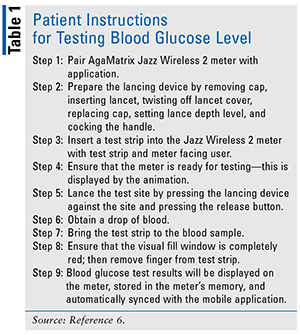US Pharm. 2017;42(11):36-37.
Diabetes mellitus refers to a group of diseases that affect how the body uses glucose. Diabetes may be classified as type 1, type 2, or gestational.1 Type 1 diabetes is associated with an autoimmune-mediated destruction of pancreatic beta cells that leads to an absolute deficiency of insulin. Type 2 diabetes is characterized by the body’s inability to effectively use or make insulin, and gestational diabetes is defined as elevated glucose levels that occur during pregnancy.
In many cases, diabetes is first recognized by associated symptoms.2 For example, symptoms of hyperglycemia include blurred vision, headache, polydipsia, polyphagia, and polyuria. Symptoms of hypoglycemia include confusion, dizziness, shakiness, and tachycardia. When glucose levels fluctuate in the absence of medications and appropriate monitoring for extended periods of time, serious complications can occur, such as heart disease, stroke, and amputation.
Epidemiology
According to a national survey, in the year 2012, approximately 29 million Americans had diabetes and 8.1 million were unaware of their condition. Although Native Americans and Alaskans are the most commonly diagnosed ethnic groups, African Americans and Hispanics follow closely behind. Comorbidities and complications are common and may include hypertension, hyperlipidemia, and cardiovascular disease. Complications cost a total of $176 billion in medical expenses during 2013 and were related to 234,051 U.S. deaths in 2010.3
Monitoring
Maintaining an appropriate blood glucose level is of the utmost importance. The most commonly employed method by which patients monitor glucose in the home setting is a blood glucose monitor. These monitors, through the collection of a small sample of blood, allow the patient to immediately document inconsistent glucose levels and adjust his or her medication and diet accordingly. To this end, frequent monitoring with a home blood glucose meter affords patients the opportunity to take control of their condition and overall health.4
Self-monitoring of blood glucose is a critical part of adequately managing the disease state. The availability of convenient, affordable, and accurate blood glucose home-monitoring equipment allows patients to control their blood glucose levels more effectively by providing a visual representation of the impact of their lifestyle choices and illustrating the effects of their medication. Patients must be able to accurately determine their blood glucose levels so that they can more effectively alter their diet, exercise, and/or medication regimens in order to maintain a healthy blood glucose range.5
Device and Mobile Application
The AgaMatrix Jazz Wireless 2 Blood Glucose Monitoring System was approved by the FDA in April 2016 for monitoring blood glucose levels. The kit contains the Jazz Wireless 2 blood glucose meter (batteries included), a lancing device with cap, 10 sterile lancets, a compact carrying case, one vial of 10 AgaMatrix Jazz test strips, an owner’s guide, a pairing/syncing guide, and a registration card.6
The Jazz Wireless 2 blood glucose meter has a simplified interface with a display area for test results, a meter button to turn on the meter and view previous test results, and a test strip port for the insertion of test strips.6 The Jazz Wireless 2 blood glucose meter and patient instructions are shown in FIGURE 1 and TABLE 1, respectively.


The AgaMatrix Diabetes Manager is the mobile application companion for the Jazz Wireless 2 blood glucose meter. The application, which is available for a variety of iOS and Android devices, allows for the addition, modification, tracking, and viewing of health data, including glucose, insulin use, carbohydrate intake, and weight. The application can graphically display the user’s health data in a timeline format. These data can then be shared with parents, caretakers, or healthcare providers.6 The AgaMatrix Diabetes Manager is pictured in FIGURE 2.

Efficacy
The AgaMatrix Jazz Wireless 2 Blood Glucose Monitoring System has been tested for accuracy by measuring blood glucose levels of venous blood samples and comparing the results with those for the YSI Model 2300 STAT PLUS Glucose Analyzer, a laboratory-quality device with a precision of ±2% or 2.5 mg/dL.7 Test results demonstrated the accuracy of the AgaMatrix Jazz Wireless 2 Blood Glucose Monitoring System, with 97.8% of the readings within ±15 mg/dL or 15% of the reference concentration.8
To assess the accuracy and usability of the AgaMatrix Jazz Wireless 2 Blood Glucose Monitoring System in the hands of the intended user, 100 laypersons with clinical diagnoses of type 1 or type 2 diabetes were asked to measure their blood glucose levels. Of these 100 subjects, who were given only the instructions and training materials routinely available in the testing kit, 99 were able to obtain measurements within ±15 mg/dL of the measured values of the manufacturer’s measurement procedure at glucose concentrations <75 mg/dL and within ±15% at glucose concentrations ≥75 mg/dL. This demonstrated that, in the hands of the target user population, the AgaMatrix Jazz Wireless 2 Blood Glucose Monitoring System was able to provide accurate results for 99% of measurements taken.8
Conclusion
The AgaMatrix Jazz Wireless 2 Blood Glucose Monitoring System is an effective glucose monitor that is easy to use and provides innovative functionality. For more information, contact AgaMatrix at www.agamatrix.com or (866) 906-4197.
REFERENCES
1. CDC. What is gestational diabetes? www.cdc.gov/diabetes/basics/gestational.html. Accessed June 26, 2016.
2. Mayo Clinic. Diabetes. www.mayoclinic.org/diseases-conditions/diabetes/basics/complications/con-20033091. Accessed June 26, 2016.
3. American Diabetes Association. Statistics about diabetes. www.diabetes.org/diabetes-basics/statistics. Accessed June 26, 2016.
4. International Diabetes Federation. Epidemiology and prevention. www.idf.org/epidemiology-prevention. Accessed June 26, 2016.
5. Boutati EI, Raptis SA. Self-monitoring of blood glucose as part of the integral care of type 2 diabetes. Diabetes Care. 2009;32(suppl 2):S205-S210.
6. AgaMatrix Jazz Wireless 2 Blood Glucose Monitoring System Owner’s Guide. Salem, NH: AgaMatrix, Inc; 2016.
7. YSI 2300 STAT PLUS Proven Technology for Glucose and Lactate. Yellow Springs, OH: YSI Inc; 2016:2. www.ysi.com/File%20Library/Documents/Specification%20Sheets/YSI-2300-Stat-Plus-Spec-sheet-B53-GL.pdf. Accessed July 5, 2016.
8. AgaMatrix. White Paper, Agamatrix Jazz Wireless 2 Blood Glucose Monitoring System Analytical Performance. Salem, NH: AgaMatrix Inc; 2016.
To comment on this article, contact rdavidson@uspharmacist.com.





